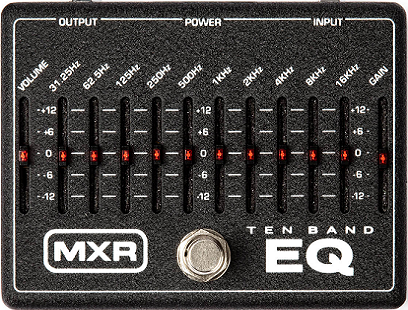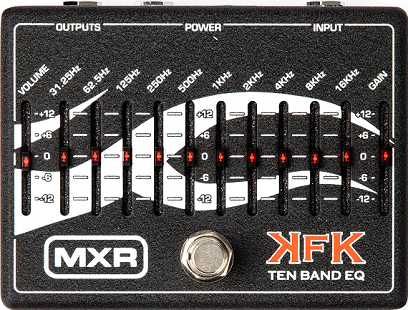M108 10-band EQ
MXR M108 10-band EQ. Equalizer. That's amusing. Who came up with the title "Equalizer"? If you consider what a graphic equalizer does, it doesn't equalize frequencies. When used as intended, it DISEQUALIZES frequencies - it doesn't make them "equal" at all. Certain frequencies are cut, or boosted, depending on the fader settings.
We believe a better term is "Tone Shaper" or "Frequency Shaper". "Equalizer" implies frequencies will be made "equal".
Definitely not what a graphic equalizer does.
Thermionic Studios has one each of these pedals:
- Thermionic Studios has one(1) M108 10-Band Eq available for rental
- Thermionic Studios has one(1) KFK1 10-Band Eq available for rental
Controls

- Fader 1 - "Volume": All volume output from this pedal.
- Fader 2 - "31.25Hz": Lowest Frequency at around 31 Hertz
- Fader 3 - "62.5Hz": 62.5 Hertz
- Fader 4 - "125 Hz": 125 Hertz
- Fader 5 - "250Hz": 250 Hertz
- Fader 6 - "500Hz": 500 Hertz
- Fader 7 - "1KHz": 1,000 Hertz. This is typically where audio engineers and audiophiles describe "midrange" frequencies existing.
- Fader 8 - "2KHz": 2,000 Hertz.
- Fader 9 - "4KHz": 4,000 Hertz - upper midrange to treble frequency
- Fader 10 - "8KHz": 8,000 Hertz - definitely "treble" territory.
- Fader 11 - "16KHz": Highest frequency at 16,000 Hertz. This is so high that many people cannot hear this frequency.
- Fader 12 - "Gain": The amount of signal boosted into the pedal. Using this, it's possible to add some overdrive, just like the gain knob of any overdrive or distortion pedal.
- Footswitch 1 - "On/Off": This switch toggles between active or engaged ("On") and bypassed ("Off").
Note that between the volume and lowest frequency faders on the left, the faders in the middle of the pedal, and between the highest frequency and gain faders on the right, MXR has labelled the enclosure with a painted indicator showing +12 dB to -12dB in the span of the faders.
Setting the fader for a particular frequency at "0" (zero) means that that frequency is being neither boosted nor attenuated. An M108 with all faders at "0" should have the same volume level and therefore sound the same on as off. This is called "Unity Gain". Moving the fader of a selected frequency up increases the volume of that frequency in the output signal; likewise, sliding that same fader below "0" reduces the volume of that same frequency.
It's also useful to note the separate Volume and Gain faders on each side of the pedal. If many or most of the frequency faders are at zero or below, the total signal level coming out of the pedal may be below the original unity volume level. In such cases, it's advisable to boost the volume or gain so as to ensure "unity gain" when turning the pedal off and on.
Bypass: Unknown
General Information
https://www.youtube.com/watch?v=5xrBGitOIc4
KFK 10-Band

This version of the 10-Band EQ was originally built for Kerry King of Slayer. It's not really any different except for the Kerry King tribal tattoo graphic across the front, and the addition of a second output. The second output allows you to plug into a second amplifier, or a second effects path. If creating a second effects path, be sure to understand the implications of having separate left and right.
Pedal Manuals
Phase Inversion:
Schematic
Artists
- Kerry King
- Additional Sources